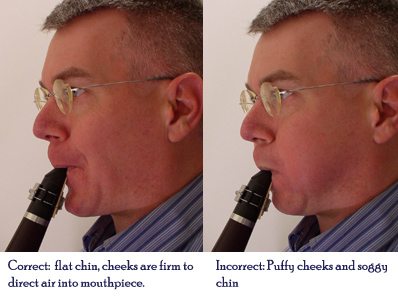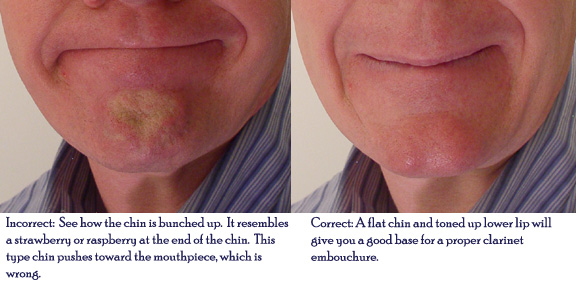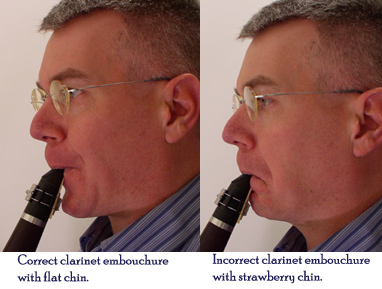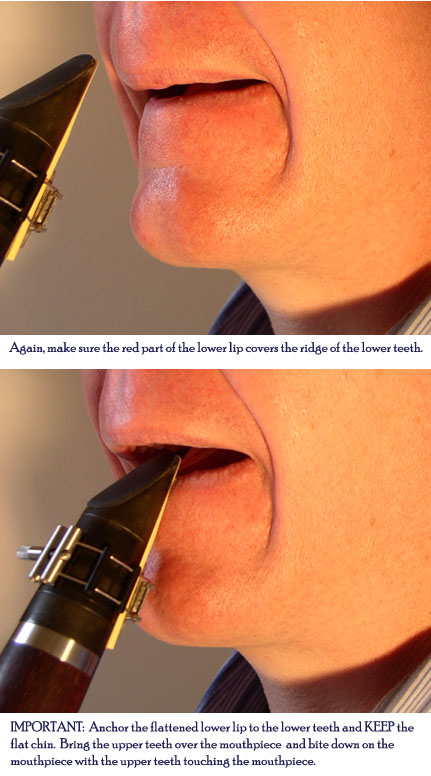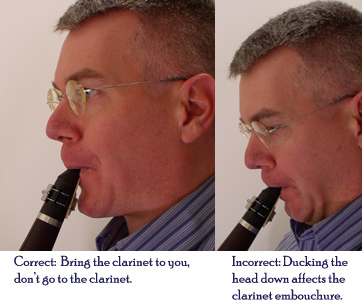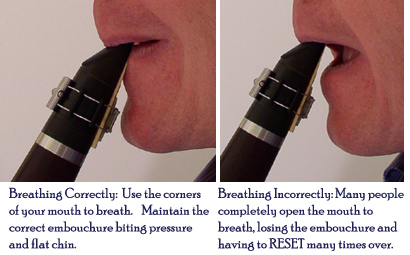Poor Clarinet Embouchure -- Free Online Clarinet Lesson 1B
Poor Clarinet Embouchure - Many people do not have any idea their embouchures are incorrect. Often, it takes a private teacher to wake them up to better principles of forming the mouth on the clarinet mouthpiece and reed.
If you do not have the luxury of a private clarinet teacher, please find a mirror and watch yourself as you blow the clarinet. After all, this is Clarinet-Now. Go get it, go get your Clarinet Now!
For experienced players wishing to improve your current clarinet embouchure, read through the descriptions of poor clarinet embouchures. Find a mirror and compare your embouchure with with each description. This troubleshooting guide to the clarinet embouchure should help you improve your clarinet sound almost immediately.
Listen to this Bumblebee
Yep, I played this Flight of the Bumblebee on Clarinet accompanied by a Squeeze Toy Giraffe. If you want to learn how to increase your speeds for any piece, etude or scale, the information is all here on Bumblebee Loops.
By the way, the video is not AI generated.
14 Types of
Poor Clarinet Embouchure
POOR CLARINET EMBOUCHURE #1
Mouthpiece floats in mouth and does not anchor mouthpiece. To test this, while you are blowing on the clarinet, try to jiggle the mouthpiece in your mouth. If it moves around, you are not biting enough and are not closing down on the mouthpiece enough. This poor clarinet embouchure will sound weak, fuzzy, harse and unfocused.
POOR CLARINET EMBOUCHURE #2
Bottom teeth touch reed. You are not cushioning the reed with lower lip. The reed should lie on the lower lip. This poor clarinet embouchure will sound like a screeching cat.
POOR CLARINET EMBOUCHURE #3
Puffing cheeks. The cheek puff shows that you are not using your facial muscles solidly or firmly to set-up your clarinet embouchure.
POOR CLARINET EMBOUCHURE #4
You use so little muscle support in your face that spit and drool comes out of the corners of your mouth. This is pretty obvious. If you have this problem, your poor clarinet embouchure is not firm enough. If you are a beginning student and are trying really hard for a long time, give yourself proper rests. You are using new muscles and they may tire quickly. Patience is a virtue. Ask your band director or clarinet teacher what you are doing wrong.
POOR CLARINET EMBOUCHURE #5
Tongue is on the reed. If the tongue is on the reed, it will not vibrate which generates the clarinet sound. We’ll touch more on the tongue with articulation.
POOR CLARINET EMBOUCHURE #6
Too much mouthpiece in mouth will sound like a goose. It is commonly described that if you put too much mouthpiece in your mouth, and then pull the mouthpiece out slowly, you will find a nice, sweet spot where you get a beautiful, full clarinet sound. How do you know you have too much mouthpiece in the mouth? You will definitely squeak or squawk every time you try to make a sound. Again, go to that point and incrementally (or a little bit at a time) pull the mouthpiece out. You will find a place where you do not squeak anymore and make a big beautiful sound. Experiment with this in front of a mirror.
WATCH THIS VIDEO FOR AN EXAMPLE OF TOO MUCH CLARINET IN THE MOUTH.
POOR CLARINET EMBOUCHURE #7
Not enough mouthpiece in mouth. This will close off the reed not allowing many or any reed vibrations at all. Either no sound or a very thin, weak sound will come out with this poor clarinet embouchure. Your face will turn red because air has nowhere to go. Try the step above on number 6. Put what you think is too much mouthpiece in your mouth and pull out slowly. Again, read about the nice sweet spot above.
POOR CLARINET EMBOUCHURE #8
Too much lower lip inside lower teeth. Looks like an old man who forgot his dentures. Even if you do not have your clarinet out right now, do this: Act like you are putting Chapstick on your lower lip. Now, look at that in a mirror. That is how the lower lip should form before you put the clarinet mouthpiece and reed on the lip. The reed should anchor the lip down in this position before or as you close the mouth down around the mouthpiece and reed.
POOR CLARINET EMBOUCHURE #9
Flatten or point the chin, not strawberry or raspberry chin.
Pushing chin up onto reed. Commonly called a “strawberry or raspberry” chin. The clarinet embouchure has a correct chin and an incorrect chin. The “strawberry” chin pushes up toward the reed and presents a “mushy” embouchure.
With the correct clarinet embouchure, the reed is anchoring down the lower lip (as described above like you are putting on Chapstick). With the reed anchoring the lower lip, the chin spreads in a downward position like toward the floor and firms up the skin between your lower lip and the tip of the chin. It is also commonly called the pointed chin.
When I describe this to my clarinet students or in clarinet clinic, allow careful attention to the amount of pressure you are biting on the clarinet mouthpiece and reed. Students usually confuse flattening the chin with opening up the mouth. Yes, flatten the chin, but keep firm teeth pressure on the mouthpiece and reed.
THE SMILE FALACY Sometimes, I have to use the smile to get a student to flatten their chin the way I want it. However, the “smile” description is not the best idea in teaching the clarinet embouchure. When you smile, the corners of the mouth move backward as if toward your ears. If you insert a clarinet mouthpiece while smiling, you will have interminable air leaks. However, the “look” of the chin is correct.
I use the “smile” description as a last resort to students who could not understand the concept of flattening the chin. Look at a mirror. Give it a good smile. Your chin will flatten the way a correct embouchure can use it. However, notice the corners of your mouth climbing back towards your ears. This is an improper use or description for the clarinet embouchure. Again, the lips should form a closed-off seal around the mouthpiece and reed like a drawstring. The chin, again, is flat or pointed but the corners of the lips are not smiling.
TRY THIS LITTLE EXERCISE RIGHT NOW! Some people just do not get it. Flattening that chin is just a hard concept to grasp. Now, try this little exercise. Do this: Place your thumb and index finger on the back of your hand. Press down and pull the fingers apart as if you are stretching the skin of the back of your hand from between those two fingers. Now, put the clarinet mouthpiece in your mouth, anchor your lower lip with the reed, close the mouth off around the mouthpiece and flatten or point the chin. If you are flattening correctly, the skin between your lower lip and chin should stretch or “firm-up” like the skin on the back of your hand stretched by the fingers.
POOR CLARINET EMBOUCHURE #10
Clarinet is held too high. This angle of clarinet affects embouchure poorly. Between a 30 and 40 degree angle is often accepted as correct. You can test this by listening to your sound as you move the clarinet around. Try this: set your embouchure, move the bell of the clarinet too high. Blow. As you are blowing, slowly bring the clarinet bell down toward your body. You will hear your sound open up and will find a “sweet spot” here that maximizes your sound. The bell of the clarinet will often end up right between your knees. Try this, but do not look down at the bell as you move it. Keep the head in an up position.
POOR CLARINET EMBOUCHURE #11
You duck your head way down as if you are looking at the floor and/or at clarinet fingerings. This angle of clarinet also affects the embouchure poorly. Act like someone is putting their thumb on your forehead and pushing it back. Another way to test this is to stand up against a flat wall. Put your head against the wall and bring the clarinet up to your face. Don’t let the clarinet control you, you control the clarinet. Bring it to you, do not go to it.
POOR CLARINET EMBOUCHURE #12
Chin moves while you are articulating with the tongue. Many young students coordinate the chin with the tongue. First of all, if your chin is moving to articulate, your tongue is moving too much. The chin should stay steady while the tongue lightly strokes the clarinet reed. Do not move the chin with the tongue.
If you are a “chin chewing clarinet articulator,” read the Clarinet-Now Clarinet Articulation page. As I take seven steps to explain clarinet articulation, step number seven states "do not move the chin while articulating."
POOR CLARINET EMBOUCHURE #13
Chin moves with each change to different notes, or playing large intervals, or when moving over the clarinet break (up or down). I’ve seen young clarinet students move the chin with every single change of note; even when rearticulating the same pitched note.
Many amateurs conquer that bad habit, but still do a violent chin movement with large intervals. The most common chin movement among all clarinet players, is crossing the break.
Blowing a good, solid stream of air as you cross the break ascending or descending is required. Keeping the embouchure steady and having the finger technique work perfectly is best for a good smooth crossing of the clarinet break.
Why is it called “the break?” Because it is a common “break,” “bump,” “gap,” “grunt,” “hitch,” in the clarinet sound among a majority of clarinetists. Even the greatest clarinetists in the world have had to deal with the “break” and have spent hours and hours of practice mastering the interval between the lower registers to the clarion register to sound smoothly.
POOR CLARINET EMBOUCHURE #14
Mouth completely opens each time you take a breath. Why lose your entire embouchure each time you take a breath? Once your embouchure is set, get used to taking air in from the corners of your mouth (the complete left and right corners of the lips). Allow the anchored reed on the bottom and the anchored teeth on top to hold steady and keep the same biting pressure on the mouthpiece. When breathing, only allow the corners of the lips to inhale. Yet, again, this is another point of musical efficiency.
Check out this description of a proper Clarinet Embouchure.
This is a question via email to me from Tahlla asking how to improve the clarinet embouchure.
Questions?: Hi! I love your website it has been helping me a lot. I have been playing clarinet for 5 years and have been doing the "strawbarrier" style embouchure and I was wondering if you had any tips on how I can get rid of that. I have been practicing in front of a mirror like you said but after a half a second my embouchure goes back to my old bad habit.
Thank you, Tahlla
Hello Tahlla,
Here are some thoughts to help your embouchure:
A half second of a flat chin, proper clarinet embouchure is already progress.
Now, we have to hold that correct embouchure for a longer amount of time.
Get in front of the mirror again with your clarinet. Play only whole notes for now on easy notes like low C (one ledger line below the staff – I know you know this but I like to describe fully).
Priority number one for now is to concentrate only on keeping the flat chin, but here are some reasons your chin goes back to the strawberry-like chin:
The strawberry chin means your skin and muscles are pushing toward the point of your chin to make that strawberry look. Now, your challenge is to make your skin and muscles go the opposite direction. Think of smiling. A good smile gives you pretty much the perfect clarinet chin. The problem with the smile is that the corners of the mouth are pulled back too far for a good clarinet embouchure.
Are you familiar with drawstring purses? You take two sides of the drawstring, pull them and it closes the purse down in an even circle. The clarinet embouchure is very similar to the drawstring purse as you do not wish air to escape out of the mouth but only into the mouthpiece.
Another great analogy that I’ve heard recently from J. Lawrie Bloom, clarinetist and bass clarinet with the Chicago Symphony Orchestra, is this, a growling dog. Have you ever seen a growling dog? Do that now and growl at the computer. Now go growl at a mirror. This gives you both a good flat chin and it tones up the upper lip some for a good clarinet embouchure. The upper lip actually curls in a little bit (which is good).
When you try the flat chin and blow on the clarinet, make sure you are still biting down with the teeth. Most often, people think that the flat chin means they stop biting on the mouthpiece. So, you now have to train yourself to bite down while having the flat chin.
This all might seem like you are taking two steps back for every one step forward, but it is well worth while. Hopefully, if your flat chin is working, your sound should open up and become a little clearer. Is this happening for you?
Goals and Exercises:
1. Try to hold the good embouchure for a whole whole note.
2. Let number one be your top priority.
3. Once you’ve accomplished number one, try some simple finger patterns like C, D, C, D, C, D, C. Slur the notes, do not articulate. Your body is so used to the old embouchure, that once you move fingers, the chin will probably go back to the old way. This is the purpose of this exercise, keeping the chin flat while moving the fingers. Now, look in the mirror while you move to these simple note patterns and concentrate on the chin.
4. Then, try only one octave scales that do not cross the break like the G scale or F scale. Again, go up and down the scale slurring only and think of the chin. It is best to do long tones, simple patterns and scales so you can primarily think of the chin and not have to think about fingers.
5. Let me know how this goes for you.
As you can tell, describing a good clarinet embouchure and trying to teach it via the website and an email is a challenge second only to doing the correct embouchure by itself. I am really glad you are learning from Clarinet-Now.com. If you have a chance, finding a private clarinet teacher would help you in the process of correcting and improving your clarinet embouchure.
A private clarinet teacher is a professional problem solver that you hire to help you. Take another look at my private clarinet teacher to get ideas on where to look for a teacher.
The number one goal is to sound better on the clarinet. Best of luck and let me hear how it is going for you.
Sincerely, Chris
For more information on proper clarinet embouchure, I recommend you look at this description from McKinney TCNJ.EDU.

